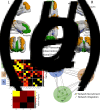Screen time, brain network development and socio-emotional competence in childhood: moderation of associations by parent-child reading
- PMID: 38314509
- PMCID: PMC11413359
- DOI: 10.1017/S0033291724000084
Screen time, brain network development and socio-emotional competence in childhood: moderation of associations by parent-child reading
Abstract
Background: Screen time in infancy is linked to changes in social-emotional development but the pathway underlying this association remains unknown. We aim to provide mechanistic insights into this association using brain network topology and to examine the potential role of parent-child reading in mitigating the effects of screen time.
Methods: We examined the association of screen time on brain network topology using linear regression analysis and tested if the network topology mediated the association between screen time and later socio-emotional competence. Lastly, we tested if parent-child reading time was a moderator of the link between screen time and brain network topology.
Results: Infant screen time was significantly associated with the emotion processing-cognitive control network integration (p = 0.005). This network integration also significantly mediated the association between screen time and both measures of socio-emotional competence (BRIEF-2 Emotion Regulation Index, p = 0.04; SEARS total score, p = 0.04). Parent-child reading time significantly moderated the association between screen time and emotion processing-cognitive control network integration (β = -0.640, p = 0.005).
Conclusion: Our study identified emotion processing-cognitive control network integration as a plausible biological pathway linking screen time in infancy and later socio-emotional competence. We also provided novel evidence for the role of parent-child reading in moderating the association between screen time and topological brain restructuring in early childhood.
Keywords: Brain network measures; children brain development; diffusion MRI; emotion regulation; screen time.
Conflict of interest statement
The authors declare the following financial interests/personal relationships which may be considered as potential competing interests: Yap-Seng Chong is part of an academic consortium that has received research funding from Abbott Nutrition, Nestec, and Danone. All other authors report no financial relationships with commercial interests.
Figures





References
-
- Batalle, D., Eixarch, E., Figueras, F., Muñoz-Moreno, E., Bargallo, N., Illa, M., … Gratacos, E. (2012). Altered small-world topology of structural brain networks in infants with intrauterine growth restriction and its association with later neurodevelopmental outcome. NeuroImage, 60(2), 1352–1366. 10.1016/j.neuroimage.2012.01.059 - DOI - PubMed
MeSH terms
Grants and funding
LinkOut - more resources
Full Text Sources

